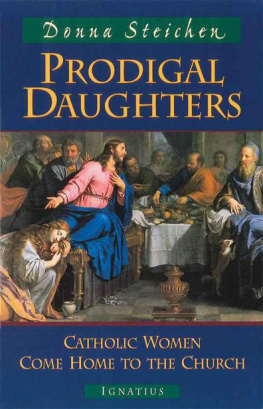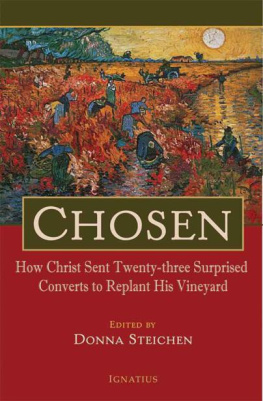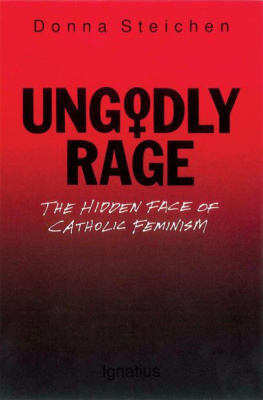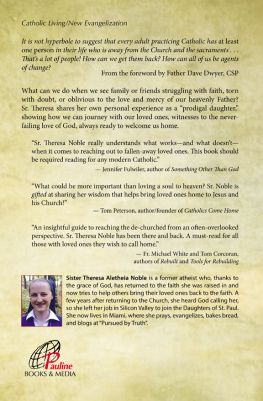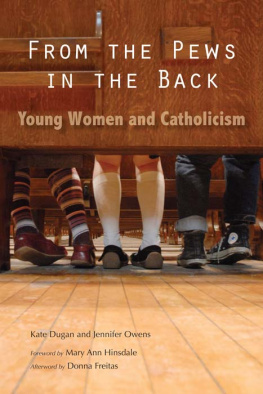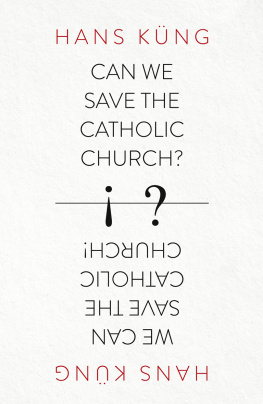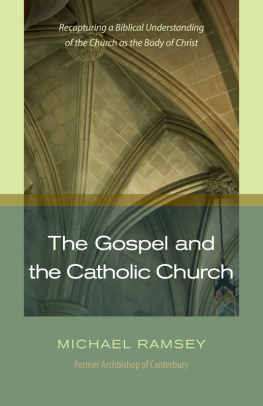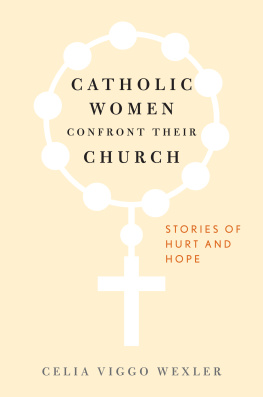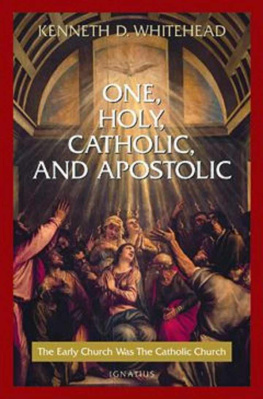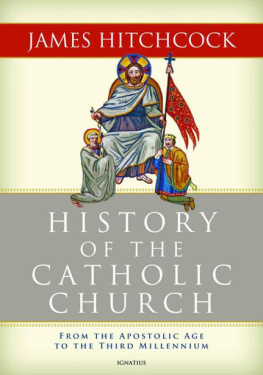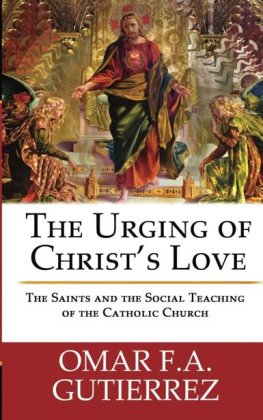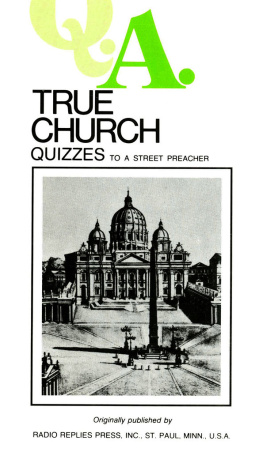PRODIGAL DAUGHTERS
PRODIGAL
DAUGHTERS
Catholic Women Come Home to the Church
Edited by
Donna Steichen
IGNATIUS PRESS SAN FRANCISCO
Cover art: Feast in the House of Simon
by Philippe de Champaigne, c. 1656
Muse des Beaux-Arts, Nantes, France
Cover design by Riz Boncan Marsella
1999 by Ignatius Press, San Francisco
All rights reserved
ISBN 978-0-89870-732-8
Library of Congress catalogue number 99-73010
Printed in the United States of America
For the contributors, who bared their private anguish and joy in hope that their experiences will help other wanderers to find the way home.For all the prodigal daughters and sons in my heart and my prayers, that they too may soon return to their Fathers house.
CONTENTS
Donna Steichen
Mary Lou Partridge Pease
Juli Loesch Wiley
Maureen Cassidy Quackenbush
Constance Buck
Kathleen Howley
Rosemary Hugo Fielding
Kathleen Brown Robbins
Marcella Trujillo Melendez
Deborah Beauman Harvey
Zoe Romanowsky
Julie Baker Maguire
Allyson Smith
Leila Habra Miller
Rachel Taylor Riley
Diane Yelenosky Spinelli
Mary Epcke Kaiser
Moira Noonan
Donna Steichen
INTRODUCTION
From unrequited love, it is said, we learn how God must feel. The truth in that remark is that God is not abstract love, but a Lover, whose love is astonishingly singular; He offers it not only corporately, to His people, but individually, to each heart, as ardently as if He had never created another in the entire universe to love. All the stories in this book are recollections of His courtship.
In times when the Catholic world is healthy, God woos most of us through the institutional channels of family, Church, and culture. But even today, when the family is fractured and the Church in turmoil, when little survives of traditional Catholic culture and the object of His love is apt to spurn Him for worldly pleasures, still His quest continues, until either He wins the heart of His beloved or death intervenes. When His courtship is successful and His love returned, He forgives past neglect and pours out His grace unstintingly; repentant sinners are as likely as anyone else to become saints. Blessed Josmara Escriv, founder of Opus Dei, urging his followers to welcome a penitent, once advised, Remember that he may yet become an Augustine, while you remain mere mediocrities.
The second Person of the triune God demonstrated the depth of His love for us when He became incarnate as the man Jesus. The Churchs Morning Prayer for Christmas Day says of His origin: Your eternal Word leaped down from heaven in the silent watches of the night Almighty though He was, He did not come as an imperious king, or as some kind of angelic sorcerer, to stun the world with His power. Instead, He came as an ordinary mortal, subject to the pains and risks of the human condition. Surrendering all majesty and sovereignty, He entrusted His vulnerable infant body to human compassion, appealing for love first with His helplessness.
It was not only to teach us by example how to live that Jesus became man. He came as the Messiah, the long-promised Savior, to suffer and die in order that the scales of ontological order could perfectly balance mercy and justice in judging men. No merely human person could reconcile Gods justice with His mercy, only Christ the Son, because He both embraces and surpasses all mankind.
Some people are troubled to learn that Gods perfection demands justice. They want to enjoy His mercy while denying His justice, because they think justice is cruel. In fact, as Caryll Houselander wrote, justice is compassion:
Justice is a supreme example of His love... Justice is the defense of the defenseless. It protects the weak, and restores to little ones those things of which they have been robbed by force.
In so giving His life, Jesus revealed what kind of being God is: a Creator of perfect compassion, whose perfection requires justice but who so loves the persons He made that He sent His only Son to ransom them from the insuperable penalties due in justice for their sins. And He offers us this salvation by inviting each unique soul, individually, to live with Him forever in Heaven.
Christs Resurrection is both a sign of fulfillment and a promise that even the repentant may attain it, a sign that His love has brought humanity into Gods glory,
Jesus describes the purpose of His life in three related parables about the relationship between God and sinners. In the first, He compares God to a devoted shepherd who leaves the main body of His flock to search out a single lost sheep. In the second, He compares Him to a tenacious housewife who stops all other activities to search for one lost coin. Finally, in the third, He compares Him to a desolate father who watches without ceasing for the return of a wastrel son.
This story of the Prodigal Son is the most fully developed of the parables. In it, He incorporates three familiar models of human behavior: the needy remorse of the bankrupt spendthrift, the jealous, unforgiving rectitude of the elder brother, and the endlessly faithful love of the father, solicitous not for himself but for his beloved lost child. Despite the title, the central character in the story is neither the prodigal son nor his sanctimonious brother, but the father with Gods heart, who watches and yearns for the absent sinner with selfless love. When the son, hungry and humiliated, turns homeward at last, his father rejoices without recrimination.
So poignantly does Jesus portray him that this father is universally recognized as an icon of Gods tenderness toward the sinner. Even people whose perspective is otherwise entirely secular respond to the theme of pure mercy and forgiveness in this parable. If we live our faith well, we hope eventually to come to reflect the Father. In the meantime, whether sons or daughters, most of us can see ourselves in the different characters of this parable at different times in our lives.
When we hear about prodigal sinners, however, we ordinarily expect them to be sons, like the figure in the parable. Throughout history, human societies have expected daughters to be more pious than sons, more constant in fulfilling the duties of their faith. Four hundred fifty years before the daughters of Jerusalem wept and prayed along the way of the Cross, Sophocles Antigone witnessed to the same expectation among pagan Greeks. Around the world and down the centuries, women have filled most of the pews at pre-dawn Masses, at Vespers, at Compline, at Rosaries and novenas.
During the past three decades, however, it became impossible to take feminine fidelity for granted. The 1960s were years of worldwide cultural revolution, and women, culture-bearers to the family, were significant both as instigators and as targets. In China, Maos Red Guard tried to crush all traces of tradition and redefine female roles along communist party lines. Among the young in the United States, anti-war activism fused with sexual permissiveness and drug experimentation in an antinomian peace movement that was often contradictorily violent. Those upheavals in society, followed by the ascent of feminism and postconciliar disorders in the Church, combined to draw women into rebellion as never before in history.
Mutiny has raged like a typhoon through American Catholicism since the mid-1960s, as theological dissenters have tried to tear down the traditional, hierarchical Church and install in her place a bureaucracy shaped and dominated by the spirit of the age. The rebellion began in Rome, during the Second Vatican Council, when manipulative clerical change agents, their theology rooted in the nineteenth-century Modernist heresy, put political spin-doctoring to ecclesiastical use. Citing ambiguous phrases from conciliar documents, they easily persuaded like-minded reporters that the Council Fathers were replacing the Churchs ancient teachings with a sensational and permissive new theology.
Next page
